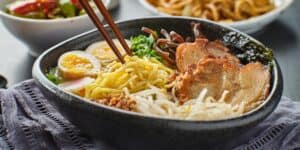Ramen, a Japanese gastronomic treasure, is no longer only a humble dish but a world phenomenon. In this article, we will embark on an exciting journey through the various and admired ramen types that create the unique and popular environment of Japan’s cuisine. Whether it is the energetic streets of Tokyo or the peaceful corners of Kyoto, the same bowl of noodles unravels the story of tradition, innovation and taste.
Shoyu Ramen: The Classic Elegance
Shoyu ramen is a kind of ramen with just soy sauce flavor and it is very popular. It was the result of a ramen shop in Tokyo in 1910. The chefs who make shoyu ramen combine various cooking ingredients to create a base sauce that is mixed with chicken broth. So this isn’t your normal soy sauce ramen from home!
Shio Ramen: The Subtle Dance of Salted Elegance
The salt ramen are generally cooked with chicken broth, but can occasionally have pork or seafood, and are a more delicate and less fatty version of ramen. It normally has a transparent color and tastes saltier than other ramen types.
Miso Ramen: The Bold Symphony of Fermented Soybean Paste
Miso ramen has its delicious flavor from fermented soybean paste which is called miso. It is made from soybeans, rice, or miso and has a white or red color. This Hokkaido originated ramen is now popular throughout Japan for its thick and flavorsome broth.
Tonkotsu Ramen: A Hearty Bowl of Porky Indulgence

Tonkotsu ramen, which has its roots in Fukuoka Prefecture, Kyushu, is considered one of the best and the richest ramen dishes. It has spread in Japan, with each region giving a distinctive treatment. This velvety and dense broth is made by boiling the pork bones until they crumble and then release collagen, which leads to a thick and sticky texture that coats the back of a spoon. Some cooks even take the richness to the next level by bringing in the hog or poultry fat into the already amazing broth.
Tsukemen: The Art of Dipping Noodles
Tsukemen, or dipping noodles, is a unique ramen experience that separates it from the regular bowl. This method of serving noodles separated from the highly aromatic broth enables diners to dip them and enjoy a memorable tasting experience with each bite. It may be in the more intense flavor of the broth which is also made with shoyu, shio, or miso variants. Tsukemen is a lively and enjoyable way of experiencing ramen that accentuates the interaction between the noodles and the broth.
Jiro Ramen: The Towering Extravaganza of Noodles
Jiro ramen, named after its founder, offers a high-rise ramen model that goes against the ordinary ramen concepts. This cuisine is unique because of the abundant amount of the thick, wavy noodles that are put on top with bean sprouts, cabbage, garlic, and a mountain of sliced pork. The soup is extremely delicious and frequently enhanced with hog fat. Jiro ramen is a feast for the eyes and taste buds, demonstrating the adventurous spirit of culinary experimentation.
Abura Soba: The Elegant Dry Ramen
Abura soba, or oil noodles, is a variant of the traditional ramen soup-based ramen, which offers a different, dry, and hearty option. In this dish, the noodles are fried in a wonderfully tasty oil-based sauce and toppings such as chashu, green onions, and a boiled egg that has been seasoned. Often accompanied by a side of broth for sipping, abura soba delivers a satisfying and unique ramen experience, emphasizing the essence of texture and bold flavors.

